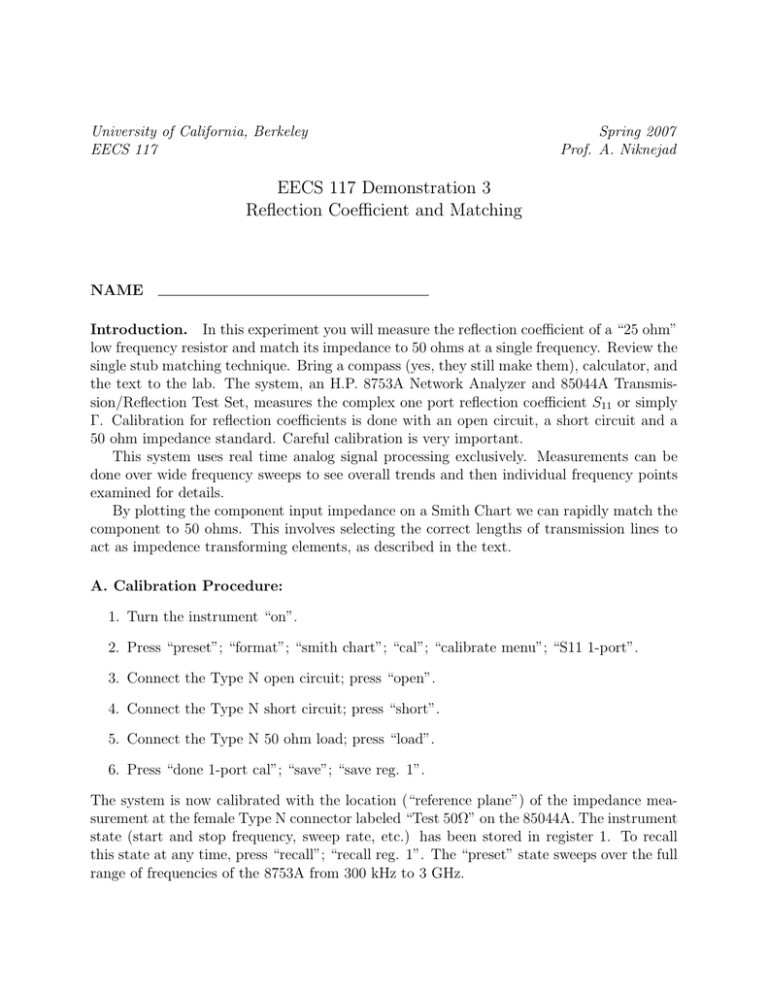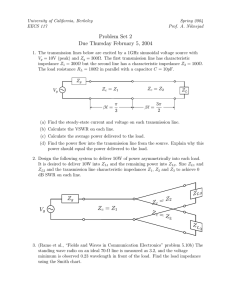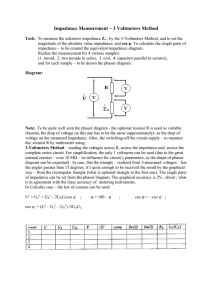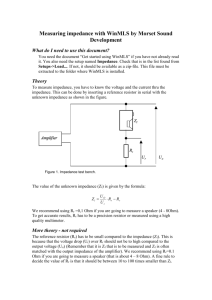EECS 117 Demonstration 3 Reflection Coefficient and Matching
advertisement

University of California, Berkeley EECS 117 Spring 2007 Prof. A. Niknejad EECS 117 Demonstration 3 Reflection Coefficient and Matching NAME Introduction. In this experiment you will measure the reflection coefficient of a “25 ohm” low frequency resistor and match its impedance to 50 ohms at a single frequency. Review the single stub matching technique. Bring a compass (yes, they still make them), calculator, and the text to the lab. The system, an H.P. 8753A Network Analyzer and 85044A Transmission/Reflection Test Set, measures the complex one port reflection coefficient S11 or simply Γ. Calibration for reflection coefficients is done with an open circuit, a short circuit and a 50 ohm impedance standard. Careful calibration is very important. This system uses real time analog signal processing exclusively. Measurements can be done over wide frequency sweeps to see overall trends and then individual frequency points examined for details. By plotting the component input impedance on a Smith Chart we can rapidly match the component to 50 ohms. This involves selecting the correct lengths of transmission lines to act as impedence transforming elements, as described in the text. A. Calibration Procedure: 1. Turn the instrument “on”. 2. Press “preset”; “format”; “smith chart”; “cal”; “calibrate menu”; “S11 1-port”. 3. Connect the Type N open circuit; press “open”. 4. Connect the Type N short circuit; press “short”. 5. Connect the Type N 50 ohm load; press “load”. 6. Press “done 1-port cal”; “save”; “save reg. 1”. The system is now calibrated with the location (“reference plane”) of the impedance measurement at the female Type N connector labeled “Test 50Ω” on the 85044A. The instrument state (start and stop frequency, sweep rate, etc.) has been stored in register 1. To recall this state at any time, press “recall”; “recall reg. 1”. The “preset” state sweeps over the full range of frequencies of the 8753A from 300 kHz to 3 GHz. B. Impedance Measurement. 1. Connect the female Type N “25 ohm” flange-mounted resistor to the male Type N connector at the reference plane and observe the impedance plot. 2. To measure quantitatively the impedance of this resistor as a function of frequency, you need a frequency marker. Press “mkr”; “marker mode menu”; “smith mkr menu”; “R+jX mkr”. The marker (an arrow) should appear. 3. The real and imaginary parts of the impedance Z = R + jX of the “25 ohm resistor”, and the frequency f , appear at the top of the Smith chart. Turn the large knob to change f and the resulting measured values of R and X. The equivalent inductance or capacitance associated with X also appears. 4. To read the magnitude and angle of the reflection coefficient Γ = S11 associated with the impedance Z, press “lin mkr”. The magnitude is given in “milliunits”, with the outer circle on the Smith chart representing one “unit”; the angle is given in degrees. To return to R and X, press “R+jX mkr”. 5. Find the normalized impedance at the frequencies listed in the table. Find the reflection coefficient magnitude and angle for the 300 MHz case. f (MHz) r = R/Z0 x = X/Z0 |Γ| 6 Γ (degrees) 100 300 1000 C. Single Stub Matching. This procedure is done at a single frequency. 1. To set the instrument to 300 MHz, press “menu”; “cw freq”; “300”; “M/µ”. 2. You must recalibrate for this new instrument state. Press “cal”; “calibrate menu”; “S11 1-port”. Then remove the 25 ohm resistor and carry out steps 3–6 of Part A, except save the result in register 2 instead of register 1. (Press “save reg 2”, not “save reg 1”. 3. Re-connect the 25 ohm resistor. 4. To obtain a marker for the measurement of the admittance Y = G + jB, press “mkr”; “mkr mode menu”; “smith mkr menu”; “G + jB mkr”. The values of G and B appear at the top of the Smith chart, given in siemens (mhos). 5. What is the air wavelength at 300 MHz? cm. 6. What is the normalized admittance y = g + jb of the “25 ohm” resistor? g= ,b= . 2 7. Insert the series GR adjustable line with the Type N adapters between the reference plane and the 25 ohm resistor. Adjust the line length by sliding the outer conductors until the constant conductance circle g = 1 on the 8753A is reached. Record the normalized admittance: g= ,b= . 8. Place the GR TEE between the adjustable line and the GR-to-Type N adapter nearest to the reference plane, and reset g = 1. Connect the adjustable GR shorting stub to the third arm of the TEE. Pull out on the black shorting stub until the lowest reflection coefficient is obtained. Record below. Adjust the series and shunt line lengths slightly to see if you can do better. Initial Γ = , Final Γ = . 9. Vary the CW frequency about 300 MHz and observe the narrow bandwidth of the match you have performed. The rapid impedance variations are caused by the addition of the series and shunt transmission lines. Press “recall”; “recall reg. 1” to restore the full frequency sweep of instrument state 1, and explore the impedance variations using the frequency marker. 3 0.39 0.38 0.37 0.4 0.11 0.13 0 0.1 5 -4 0.15 0.12 0.36 0.9 1.2 3 0.6 0.4 1.6 -60 0.7 1.4 0.8 -55 1.0 0 -5 6 0.14 0.35 9 0.1 0. 44 0 -65 .5 7 0.0 1.8 2.0 CAP AC ITI VE R EA CT AN CE 0.4 2 -35 .41 4 0.0 0 -4 0.3 6 0 0. -70 (-j CO M PO N EN T 0.4 0.0 8 3 0.3 1.0 o) jB/Y E (NC TA EP C 5 -7 US ES IV CT DU N I R O ), Zo X/ RESISTANCE COMPONENT (R/Zo), OR CONDUCTANCE COMPONENT (G/Yo) 0.2 0.4 0.6 0. 8 0.2 9 -30 -80 50 20 10 5.0 4.0 3.0 2.0 1.8 1.6 1.4 1.2 1.0 0.9 0.8 0.7 0.6 0.5 0.4 0.3 0.2 0.1 IND UCT IVE 20 10 80 6 0.0 0.4 4 1.0 RE AC TA 75 NC EC OM PO N EN T 1.0 5.0 0.28 5 0.0 4.0 0.22 0.3 0.2 5 0.4 0.3 1 0.6 85 0.8 0.2 31 0. 7 0.1 0.1 0.4 90 (+ jX /Z 0.0 5 0.4 5 20 10 20 50 0.2 0.25 0.26 0.24 0.27 0.23 0.25 0.24 0.26 0.23 0.27 EFLECTION COEFFICIENT I N R D E G REES LE OF ANG ISSION COEFFICIENT IN TRANSM DEGR LE OF EES ANG 0.6 0.2 -85 0. 8 4 0.0 0.6 0.28 6 0.4 0.3 0.0 —> WAVELE NGTH S TOW ARD 0.0 0.49 GEN ERA 0.48 TO R— 0.47 > 70 44 0. 0.5 06 0. 25 0.22 0.49 65 0.6 60 2.0 1.8 0.3 1 — D LOAD < OWAR HS T 0.47 NGT ELE V WA <— -90 1.6 30 9 0. 1 4 2 0.2 0.3 55 1.2 45 50 1.0 0.9 0.8 1.4 0.7 ) /Yo (+jB 4 0.2 9 0.2 0.2 35 0.2 -20 0. 4 0.2 0.1 0.3 0.3 4 R ,O o) VE TI CI PA CA E NC TA EP SC SU 40 8 3 0.35 -25 7 0.4 31 0. 0. 0.8 0.4 1.0 0.0 0.36 0.1 2 0.4 3.0 1 0.4 0.37 -15 8 0.0 0.13 0.38 4.0 9 0.12 5.0 0.0 0.39 -10 0.11 50 0.1 19 0. 0.48 Smith Chart 0.14 0.15 0.1 6 0.3 3 0.1 7 2 0.1 8 0.4 3.0 15 10




